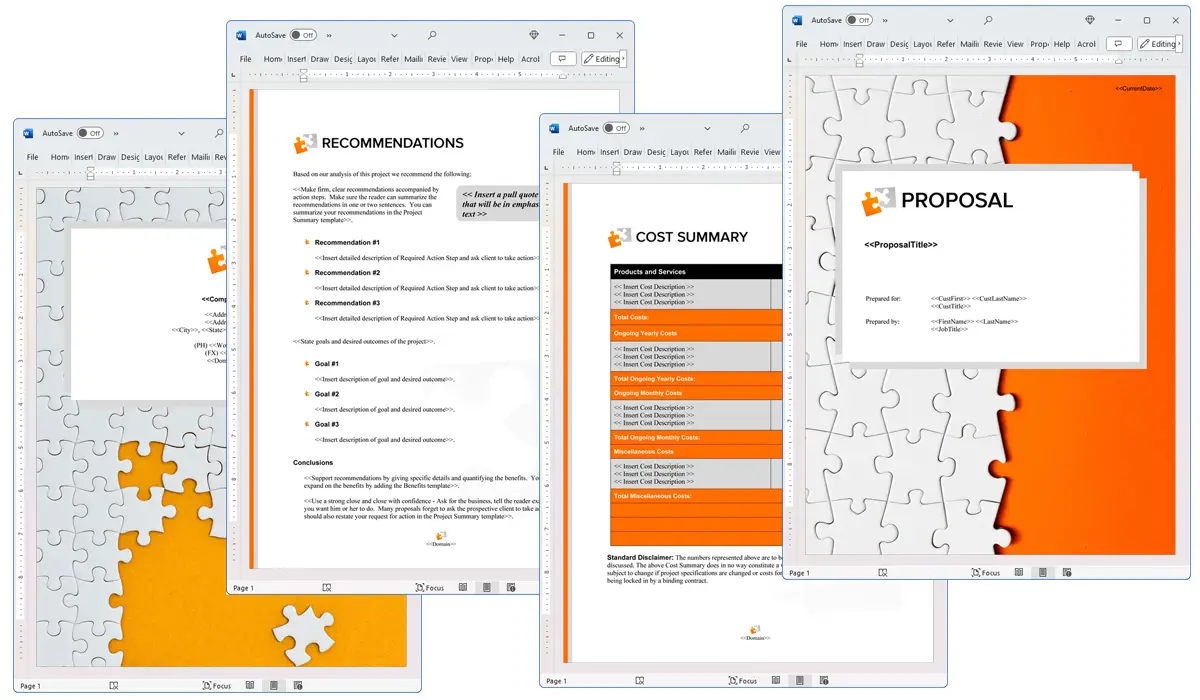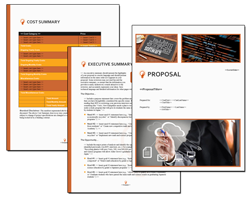What is the Logistics chapter used for?
Proposal Kit Professional Bundle adds more design themes, all six Contract Packs,
a project management library, and Expert Edition software.

Illustration of Proposal Pack Concepts #15
We include this Logistics chapter template in every Proposal Pack, along with thousands more. You assemble this chapter with others in various combinations to create custom-tailored business proposals, plans, reports, and other documents. Proposal Packs apply custom visual designs to the templates, giving the final documents a consistent professional finish.
 DOWNLOADABLE, ONE-TIME COST, NO SUBSCRIPTION FEES
DOWNLOADABLE, ONE-TIME COST, NO SUBSCRIPTION FEES
Overview of the Logistics Chapter
The Logistics chapter is an important part of a business proposal, especially when the proposal involves the coordination and management of complex operations. This chapter is designed to detail how a business manages the flow of goods from the point of origin to the point of consumption in order to meet customer or corporate requirements. Effective logistics are important for companies dealing with the production and movement of goods, as they impact both efficiency and profit margins.
How is the Logistics Chapter Used?
In a business proposal, the Logistics chapter is used to provide a clear and structured overview of the company's logistics and operational strategies. This section is tailored to reassure potential clients or partners that the business has robust systems in place to handle complex logistical challenges. It outlines the operational framework, the supply chain management strategy, and the methods used to ensure smooth and efficient delivery of services or products.
What is Included in the Logistics Chapter?
The Logistics chapter typically includes several key elements:
- Supply Chain Management: Detailed information about the suppliers, manufacturing processes, and delivery systems.
- Transportation: Methods and resources for transporting goods, including the types of vehicles used, route planning, and contingency plans for potential disruptions.
- Warehousing and Storage: Details on warehousing facilities, storage conditions, and inventory management systems.
- Handling and Packaging: Descriptions of how products are packaged and handled to ensure they are delivered in optimal condition.
- Regulatory Compliance and Safety Standards: Information on adherence to industry standards and regulatory requirements, ensuring that operations are legal and safe.
Use Case Examples for the Logistics Chapter
- Supply Chain Proposals: Detailing the management of a seamless flow from suppliers through to customers.
- Logistics Services Proposals: Outlining how a company can improve another business's logistical needs from warehousing to distribution.
- Transportation Solutions: Proposals for companies providing freight and delivery services across diverse terrains and locations.
- Food and Beverage Industry: Managing perishable goods, detailing the cold chain processes, and ensuring timely delivery to prevent spoilage.
- Grocery Supply Chain: Describing the complete process from farm to grocery shelves, emphasizing efficiency and freshness.
Key Takeaways
- The Logistics chapter is crucial for proposals involving complex movement and production of goods.
- It reassures the proposal reader of the company's ability to manage and optimize logistical operations.
- Includes important details about transportation, supply chain management, and regulatory compliance.
- Can be adapted to suit various industries including food, beverage, and any goods-dependent sector.
- Demonstrates a company's readiness to handle logistical challenges efficiently and effectively.

Illustration of Proposal Pack Software #2
 What Our Clients Say
What Our Clients SayYour templates have helped me out far beyond what words could express. Thank you once again."
 4.7 stars, based on 845 reviews
4.7 stars, based on 845 reviewsRelated Chapters
- Production Schedule
- Data Management
- Process Management
- Distribution
- Transportation
- Inventory Management
- Supply Chain
- Sourcing and Fulfillment
- Suppliers
- Routes
- Routing
- Payload
- Global
- Shortages
- Vehicles
- Vessels
- Aircraft
- On-Demand
- Reverse Logistics
- Demand Planning
- Tagging
- Load Sequence
- Disruptions
- Agriculture
- Moving Services
- Loading Plan
- Staging
- Relocalization
- Materials Planning
- Customs
- Convoys
- Just in Time
- Sequencing
- Food Chain
- Glocalization
Samples Using the Logistics Chapter
Document Layouts Using the Logistics Chapter
- Import Export Services Proposal
- Transportation Logistics Project Proposal
- Disaster Relief and Recovery Proposal
- Request for Proposal (RFP) Transportation Services
- Beverage or Food Manufacturing Project Proposal
- Supply Chain Logistics Project Proposal
- Transportation Shipping Services Proposal
- Hotel Facilities Services Proposal
- Vaccine Production and Distribution Proposal
- Minimizing Tariff Exposure Proposal Template
- Vessel Repair and Upgrade Project Proposal
- Logistics Research Project Proposal
- Business Continuity Services Proposal
- Customs Clearance and Forwarding Proposal Template
- Supply Chain Disruption and Risk Report
- Research Expedition Grant Funding Request
- Supply Chain Optimization Proposal Template
- Ship Building Project Proposal

The Logistics chapter and other chapters are integrated into a Word document as illustrated here in the Proposal Pack Children #3 design theme. There are hundreds of design themes available, and every design theme includes the Logistics chapter template.
A proper business proposal will include multiple chapters. This chapter is just one of many you can build into your proposal. We include the complete fill-in-the-blank template in our Proposal Pack template collections. We also include a library of sample proposals illustrating how companies in different industries, both large and small, have written proposals using our Proposal Packs. This template will show you how to write the Logistics.
We include a chapter library for you to build from based on your needs. All proposals are different and have different needs and goals. Pick the chapters from our collection and organize them as needed for your proposal.
Using the Proposal Pack template library, you can create any business proposal, report, study, plan, or document.
 Ian Lauder has been helping businesses write their proposals and contracts for two decades. Ian is the owner and founder of Proposal Kit, one of the original sources of business proposal and contract software products started in 1997.
Ian Lauder has been helping businesses write their proposals and contracts for two decades. Ian is the owner and founder of Proposal Kit, one of the original sources of business proposal and contract software products started in 1997.By Ian Lauder
 Published by Proposal Kit, Inc.
Published by Proposal Kit, Inc.


 Cart
Cart
 Facebook
Facebook YouTube
YouTube X
X Search Site
Search Site